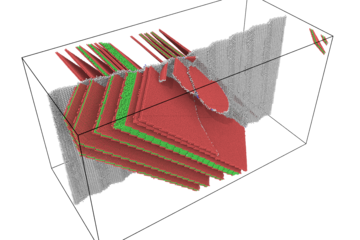All genres
1961.
Talk
Computational modeling of TiAl microstructures which developed microcracked grain boundaries. Institut für Metallkunde und Metallphysik RWTH-Aachen, Aachen, Germany (2006)
1962.
Talk
Investigating the nanomechanical properties of polymer thin films. MSU - Conference, MPI für Eisenforschung GmbH, Düsseldorf, Germany (2006)
1963.
Talk
The Nature of Laves Phases - Case Studies on Selected Binary and Ternary Transition Metal Systems. MRS Fall Conference 2006, Boston, MA, USA (2006)
1964.
Talk
Thermo-Mechanical Treatment of Spring Steels. COM 2006, Conference of Metallurgists, Advanced Steels, Montreal, Québec, Canada (2006)
1965.
Talk
3D Orientation microscopy in a FIB – SEM. SBPMat 2006 - Brazilian MRS - meeting, Florianópolis, Brazil (2006)
1966.
Talk
Computational modeling of grain boundary microcrack nucleation using a slip interaction based definition of boundary character. Risø National Laboratories, Roskilde, Denmark (2006)
1967.
Talk
A Constitutive Model for Glassy Polymers with Shear Transformation Zones Plasticity and Reptation-Based Viscoelasticity. MMM Third International Conference Multiscale Materials Modeling, Freiburg, Germany (2006)
1968.
Talk
A Study of Deformation and texture Evolution during Nanoindentation in a Cu Single Crystal using Phenomenological and Physically-Based Crystal Plasticity FE Models. MMM Third International Conference Multiscale Materials Modeling, Freiburg, Germany (2006)
1969.
Talk
Relative Importance of Nucleation vs. Growth for Recrystallisation of Particle-containing Fe3Al Alloys. Fundamentals of Deformation and Annealing Symposium, Manchester, UK (2006)
1970.
Talk
Recent Progress in the 3D Experimentation and Simulation of Nanoindents. Symposium Fundamentals of Deformation and Annealing, Manchester, UK (2006)
1971.
Talk
A Slip Interaction Based Measure of Damage Nucleation in Grain Boundaries. 3rd International Conference on Multiscale Materials Modeling, Freiburg, Germany (2006)
1972.
Talk
Neues aus der Eisenzeit - Simulationen und Experimente in der Kristallmechanik und frischer Hummer. Kolloquium an der Bundesantalt für Materialforschung (BAM), Berlin, Germany (2006)
1973.
Talk
Konstitutionsuntersuchungen im System Nb-Cr-Al: Erste Ergebnisse und weitere Planungen. Workshop: The Nature of Laves Phases VII, MPI für Metallforschung Stuttgart, Germany (2006)
1974.
Talk
Spherical indentation modeling for the investigation of primary recrystallization in a single-crystal nickel-base superalloy. Plasticity, Halifax, Canada (2006)
1975.
Talk
Slip Interactions Leading to Damage Nucleation in Grain Boundaries. Plasticity Conference 2006, Halifax, Canada (2006)
1976.
Talk
3D EBSD characterization and crystal plasticity FE simulation of the texture and microstructure below a nanoindent in Cu. Plasticity Conference 2006, Halifax, Canada (2006)
1977.
Talk
Orientation Microscopy on Nanostructured Electrodeposited CoNi Films. Thermec - 2006, Vancouver, Canada (2006)
1978.
Talk
Micomechanical Modeling of large plastic deformation in semi-crystalline polymers. Plasticity, Halifax, Canada (2006)
1979.
Talk
Mechanism-oriented steel development. New Methods of Steel Design, Aachen, Germany (2006)
1980.
Talk
3D-Orientierungsmikroskopie mittels FIB-SEM: Eine neue Dimension der Materialcharakterisierung. DGM, 5. AK-Treffen - Mikrostrukturcharakterisierung im REM, Halle, Germany (2006)











